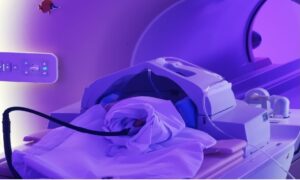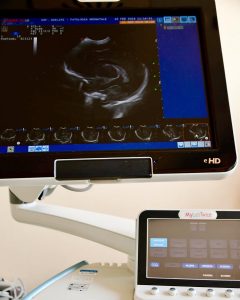After a perfect first pregnancy we thought that nothing can go wrong with having children. Then, there was a miscarriage. We mourned, recovered, and tried again. Everything was going well. We were getting peace of mind. January 15th, 2016 was the day our life changed: the 34-week routine ultrasound revealed that our daughter’s brain ventricles were severely dilated. Bad news, and the worst is, you do not even know how bad. In two weeks we found out she had Intraventricular Hemorrhage (IVH) with venous infarction somewhere between week 25th and 30th of gestation. In the womb, this is an extremely rare event. Bad luck, and you still do not know how bad. But, at some point the ventricles appeared to be expanding, so her birth was accelerated in anticipation of a surgery to treat hydrocephalus.
Anna was born in Rotterdam on February 8th, 2016. Unexpectedly, her head circumference was normal. Still, her ventricles were dilated. Thus, the local doctors concluded that her brain was underdeveloped. We should expect mild to severe disability, mainly cognitive due to White Matter Damage (WMD). And, she might develop epilepsy. Impossible to say more at this stage – they added – so go home, and we will see each other every three months for follow up.
We were in shock. Psychological support was offered, but we declined. We wanted to think, ask more questions, understand. The day after we insisted to get an additional ultrasound. There we met some people really passionate about children’s brains, Paul Govaert and his pupil Jeroen Dudink. “This case is different from many others I have seen” – said Dr. Govaert – “and I see there’s a lot going on in this brain”. Still wait and see, but – we thought – perhaps there is hope.
We still wanted to know more. Doctors studying children’s brains turn out to be a club of scientists who not only have passion, experience and knowledge, but also see the importance of sharing all this with the children’s parents. Eventually, we got in touch with another member of the club, Luca Ramenghi. We contacted him out of blue on a Saturday night, and he replied immediately. We will never forget reading Dr. Ramenghi’s email at 5 o’clock in the morning while feeding Anna. That included a clear explanation of what IVH is, why it is so common in premature babies, and importantly, why having IVH in the womb is an entirely different story. Anna wasn’t premature, so her hemorrhage would have been more stable and with a higher chance of recovery through brain plasticity.
Anna is now only 9 weeks old so it is too early to make conclusions. However, in one thing Dr. Ramenghi was already right. Anna’s ventricles have stabilized, so there’s no need for surgery. Currently, Anna is an adorable little bundle of joy who sleeps a lot, has curious big eyes and energetic little arms and legs. She is not yet smiling and she hates the tummy time, but we try to be patient and give her some more time. The support and the encouragement we have received from these doctors has been crucial to keep us going, for it is based on a combination of understanding and hard facts. Hard facts are difficult to find for brain hemorrhages occurring in the womb, because they are rare and pooling them together is a daunting task. We hope that Anna’s experience will contribute to this knowledge, particularly with a view to supporting other parents in this challenging journey.
After two years…
Anna is 2 years now and she is doing great! She almost walks the stairs, dresses herself (almost) independently and speaks three languages. From the age of 3 months she was followed by the physiotherapist to work on her low tone and slight right side weakness. She has always got some proper shoes to help her walk better but otherwise did not need extra intervention.
She has now developed a slightly lazy eye and needs glasses for correction but the doctors are confident this will be resolved and that probably this is not even related to her brain trauma. It is too early to celebrate, but so far she has surpassed everybody’s expectations and hopefully will keep on doing so.




